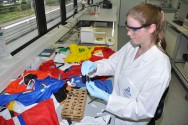
TÜV Rheinland purchased 90 soccer jerseys of teams participating in the World Cup in 2014 and tested these shirts for toxic substances and quality. The laboratory tests established that more than 30% of the fan T-shirts exceeded the limit values for the toxic substances tested. 32 shirts exceeded the European limit for phthalates, which are plasticizers primarily used for prints on textiles. Plasticizers are suspected of acting like hormones and are therefore banned from use in textiles. They can easily be replaced with other substances.
Test results
Five T-shirts even exceeded the European limit for cadmium. A heavy metal, cadmium can also prove hazardous in higher concentrations and can cause skin reactions, for example. Another product even overstepped the European threshold for azo dyes. Certain azo dyes are carcinogenic and are therefore banned from use in textiles.
In 25 of the shirts, the quality of workmanship was also inadequate. The T-shirts also presented further problems after washing, with testers pointing out changes in 28 of the products.
Marijn Krijger, spokesman TÜV Rheinland Nederland: “The results of the test are shocking. Every third shirt is so full of toxins that they are not allowed to be sold in Europe or the U.S.. Only 30 fan jerseys were free from toxic substances and passed all of the laboratory tests.
The T-shirts purchased are not official FIFA products or T-shirts from the jersey manufacturers. Instead, the children’s T-shirts tested came from markets, souvenir shops or the Internet, with an average price of €15 per jersey.










